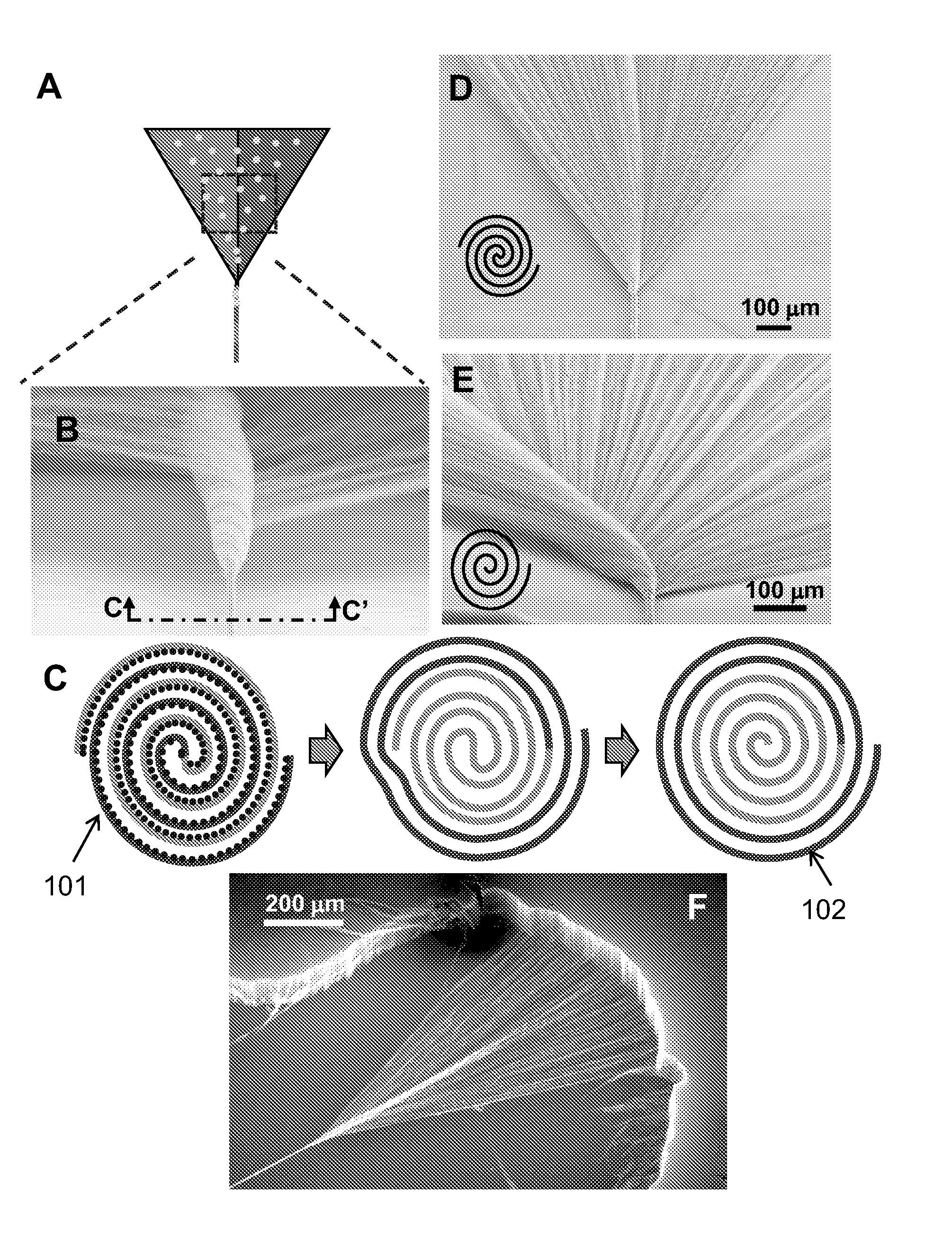Fabrication of Biscrolled Fiber Using Carbon Nanotube Sheet
a technology of carbon nanotubes and biscrolled fibers, which is applied in the direction of catalyst activation/preparation, metal/metal-oxide/metal-hydroxide catalysts, metal/metal-oxide catalyst activation/preparation, etc., can solve the problems of reducing the loading level and durability, the functionality of nanopowder and nanofibers is often degraded, and the multi-functional materials are unspinnable. , to achieve the effect o
- Summary
- Abstract
- Description
- Claims
- Application Information
AI Technical Summary
Benefits of technology
Problems solved by technology
Method used
Image
Examples
example 1
[0203]This Example 1 demonstrates the biscrolling process using solution deposition of guest MWNTs on host CNT sheets that are orthogonal. Though the sheets comprise MWNTs, the sheet nanofibers of the host are called CNTs in this example in order to avoid confusion with the solution deposited guest MWNTs. As illustrated in FIG. 5A, to prepare the free-standing CNT sheet stack, CNT sheets 501 were placed onto a wireframe 502. To prevent collapse of the sheets during solution deposition of MWNT suspension, two layers of the host CNT sheets were placed in the orthogonal direction relative to other layers of host sheets. Suspension of MWNT powder was prepared in ethanol and then deposited onto CNT sheet stack using a pipette. FIG. 5B illustrates the deposited MWNT powder 503 on the CNT sheet stack. After evaporating the solvent, a thin layer of the guest MWNTs was formed on the host CNT sheet stack.
[0204]To increase the thickness of the guest MWNT layer, several layers of guest MWNTs we...
example 2
[0205]This Example 2 describes the biscrolling process using electrophoretic deposition (EPD), which can deposit a large variety of guest materials onto the solid-state-spun CNT sheets. FIG. 6 schematically illustrates such a process of electrophoretic deposition. Although the deposition of nanoparticles over metals through electrophoresis has already been studied [R. Krupke et al., Adv. Mater. 18, 1468 (2006); A. K. Pal et al., Thin Solid Films 476, 288-294 (2005); P. Poulin et al., Carbon 40 1741-1749 (2002); S. K. Kim et al., J. Nanosci. Nanotechnol. 6, 3614-3618 (2006); and A. R. Boccaccini et al., Carbon 44, 3149-3160 (2006)], it is believed that this is the first demonstration of electrodeposition of nanoscale material onto CNT sheets.
[0206]Utilizing the mechanical strength of the sheet, this process makes possible the fabrication of free-standing sheets or ribbons mostly consisting of nanoparticles that cannot be easily assembled into yarns. The technology also enables a cont...
example 3
[0214]This Example 3 describes the biscrolling process using filtration-based deposition. In this process, the guest material to be deposited was dispersed in a suitable liquid medium using ultrasonication. Surfactants are sometimes used as the dispersing medium apart from the most commonly used mediums viz. de-ionized water and isopropanol. The filter for filtration deposition was a stack of MWNT sheets placed on a cellulose nitrate filtration membrane (Whatman, pore size was 0.45 μm, approximate thickness of 120 micrometers). Multiple layers of the MWNT sheets, typically one to three layers, were placed on the filter membrane, and then densified by wetting with isopropanolError! Reference source not found. The suspension of the guest material was then deposited onto the MWNT sheets / membrane through filtration. The filtration deposition of well dispersed suspensions formed a homogenous layer of the guest material on top of the membrane. After the filtration, the guest / MWNTsheet / fil...
PUM
| Property | Measurement | Unit |
|---|---|---|
| weight percent | aaaaa | aaaaa |
| weight percent | aaaaa | aaaaa |
| weight percent | aaaaa | aaaaa |
Abstract
Description
Claims
Application Information
 Login to View More
Login to View More - R&D
- Intellectual Property
- Life Sciences
- Materials
- Tech Scout
- Unparalleled Data Quality
- Higher Quality Content
- 60% Fewer Hallucinations
Browse by: Latest US Patents, China's latest patents, Technical Efficacy Thesaurus, Application Domain, Technology Topic, Popular Technical Reports.
© 2025 PatSnap. All rights reserved.Legal|Privacy policy|Modern Slavery Act Transparency Statement|Sitemap|About US| Contact US: help@patsnap.com



